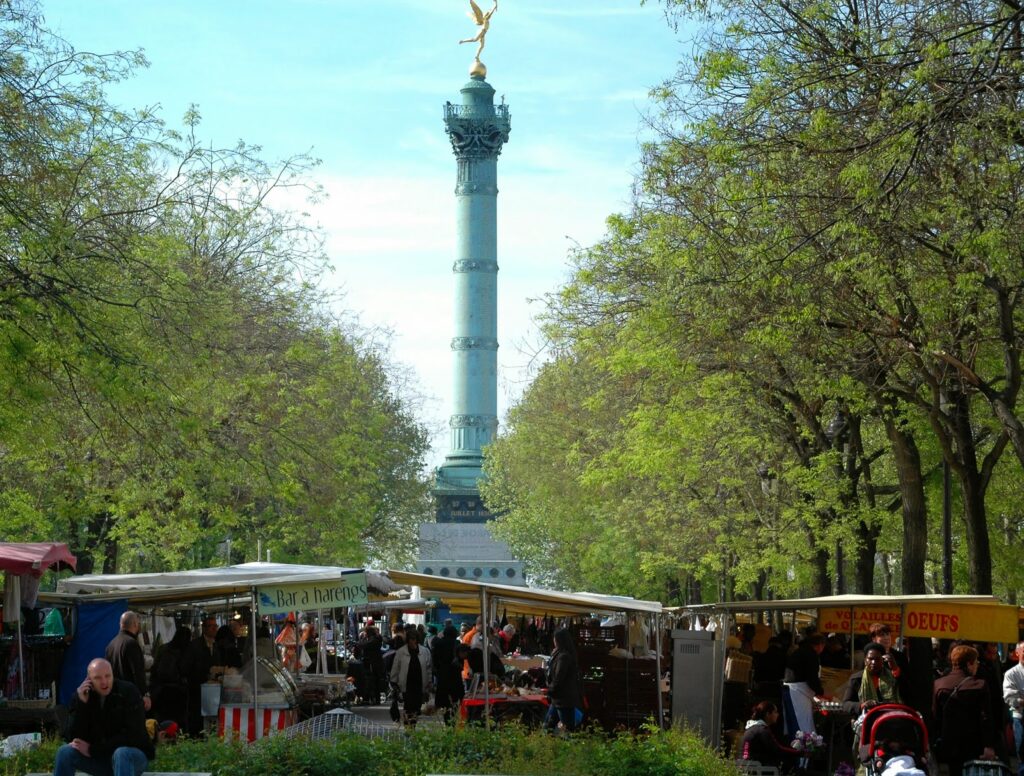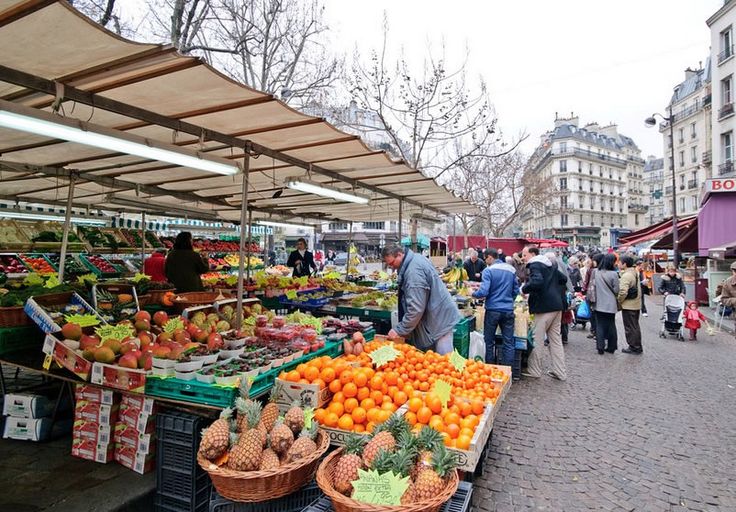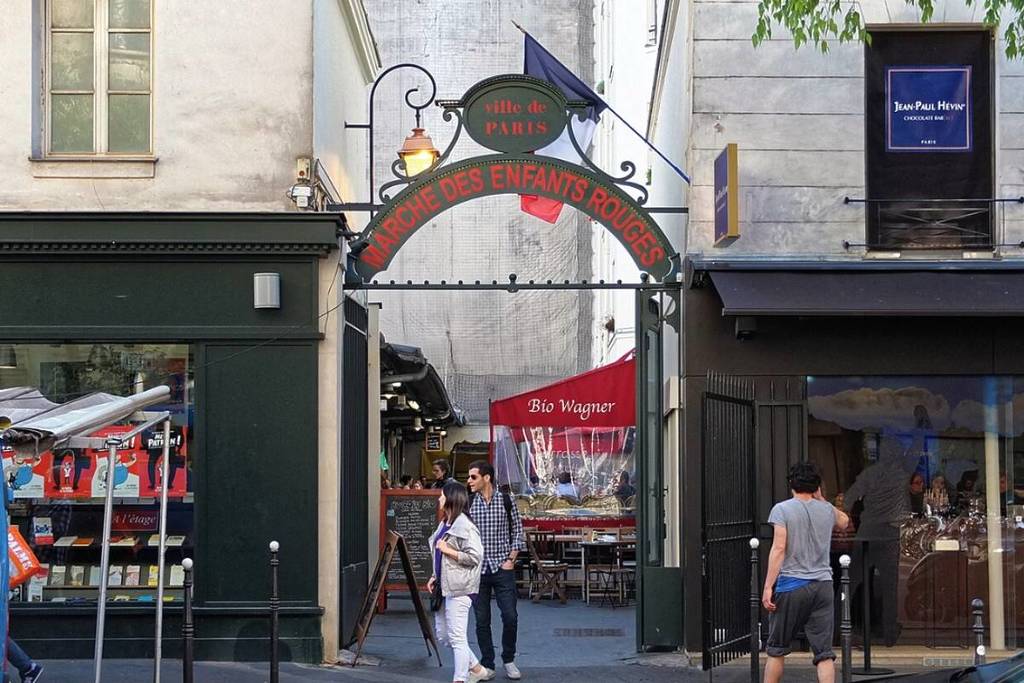Parisian Market Experiences
Okay, let’s wander through three distinct Parisian market experiences. Close your eyes for a moment, take a breath, and let’s step into the vibrant heart of Paris…
1. Marché Bastille: The Grand, Bustling Spectacle
Metro: Bastille – Lines 1, 5, 8
Location: Boulevard Richard Lenoir, between Rue Amelot and Rue Saint-Sabin, 11th Arrondissement
Hours: Typically Thursday & Sunday mornings, approx. 7:00 AM – 2:30 PM/3:00 PM
Website/Info: Often listed on Paris Info or the Mairie de Paris site

The Vibe: Energetic, sprawling, diverse, and quintessentially Parisian. This is one of the city’s largest open-air markets, and it feels like it. It’s a river of people flowing between stalls under the green canopy of trees lining the Boulevard Richard Lenoir, with the Colonne de Juillet (July Column) standing sentinel nearby.
Immersion:
- Sight: As you approach, the first thing you see is the sheer scale – rows upon rows of stalls stretching down the wide boulevard. Brilliant pyramids of citrus fruits gleam in the morning sun, contrasting with the deep greens of lettuces and the earthy tones of potatoes and onions piled high in wicker baskets. You’ll see vendors, often robust men and women with weathered hands and aprons, expertly arranging their wares. Shoppers pull colourful chariots de courses (shopping trolleys), navigating the throng. Look up occasionally to see the classic Haussmannian apartment buildings framing the scene.
- Sound: It’s a lively cacophony. The rhythmic thump-thump-thump of butchers chopping meat blends with the cheerful, sometimes booming, calls of vendors announcing their prices (“Allez, les belles fraises, trois euros la barquette!” – Come on, lovely strawberries, three euros a punnet!). Chatter in French, punctuated by laughter and the occasional tourist’s query in English or Spanish, fills the air. You hear the crinkle of paper bags, the clatter of scales, and the friendly banter between regulars and their favourite fromager (cheesemonger).
- Smell: The air is thick with competing, delicious aromas. The most dominant is often the irresistible scent of roasting chickens turning slowly on spits, their skin crackling, juices dripping onto potatoes below. This mingles with the pungent, earthy smell of dozens of cheeses, from creamy Brie de Meaux to sharp Roquefort. Breathe deeper, and you’ll catch the salty tang of the seafood stalls, laid out on ice, the sweet perfume of seasonal flowers, and the warm, comforting scent of fresh baguettes and pastries from a nearby boulangerie stall.
- Interactions: Interactions are generally brisk but friendly. Watch how Parisians expertly point to the exact items they want, engaging in brief, knowledgeable exchanges with vendors about ripeness or origin. There’s an efficiency to it, but a smile and a polite “Bonjour, Monsieur/Madame” go a long way.
Etiquette Tips:
- Greet the vendor: Always start with a polite “Bonjour.”
- Don’t handle produce: Point to what you want or let the vendor choose for you unless invited to touch.
- Queue patiently: Lines can form at popular stalls.
- Bring your own bag: It’s eco-friendly and practical. Many vendors charge for bags.
- Have small change: While cards are increasingly accepted, cash is still handy, especially for smaller purchases.
What to Buy:
- Lunch! This is the main event. Try the Moroccan couscous or tagine, a Lebanese mezze plate, Japanese bento, an organic burger, or classic French dishes depending on the current vendors.
- Fresh Crepes: A perfect sweet treat.
- Speciality Produce: Check out the organic fruit and veg stall if you need groceries.
- A Glass of Wine: Some stalls offer wine to accompany your meal.
3. Marché Mouffetard: The Old-World Charm Street
Metro: Place Monge – Line 7 or Censier-Daubenton – Line 7
Location: Rue Mouffetard, mainly between Rue de l’Arbalète and Square Saint-Médard, 5th Arrondissement
Hours: Tuesday-Saturday mornings (approx. 8:00 AM – 1:00 PM), Sunday mornings. Note: Many shops along the street are open longer/different hours.
Website/Info: This is more of a market street than a single market; info often found on Latin Quarter guides like this one from Paris Info

The Vibe: Picturesque, traditional, and brimming with neighbourhood charm. This isn’t a market set up for a day; it’s a permanent market street. The narrow, cobbled Rue Mouffetard gently slopes downhill, lined with historic buildings housing dedicated food shops – fromageries, boulangeries, boucheries, charcuteries, primeurs (greengrocers) – whose displays spill out onto the pavement, especially on market days. It feels like stepping into a bygone era of Paris.
Immersion:
- Sight: It’s incredibly photogenic. Imagine narrow cobblestones underfoot, slightly crooked medieval-looking buildings leaning inwards, painted signs advertising cheese or wine. On market mornings, the street is pedestrianised and filled with locals and tourists alike. Greengrocers’ stalls overflow with seasonal produce, carefully arranged. Cheesemongers display their pungent wheels and wedges behind glass, chalkboards announcing specials. Butchers hang cured meats, and fishmongers present glistening fish on beds of ice. Flowers cascade from buckets outside a fleuriste. Look for the charming fountain at Square Saint-Médard at the bottom.
- Sound: The sounds are more intimate here. You hear the friendly greetings between shopkeepers and regulars, the gentle murmur of conversation, perhaps the strains of an accordion player near the church of Saint-Médard. The clang of an old shop bell, the slicing of cheese wire, the rustle of paper wrapping a purchase – it’s a softer, more neighbourhood-focused soundscape.
- Smell: A delightful blend of traditional French food aromas. The rich, yeasty smell of freshly baked bread from the boulangerie is pervasive. This mixes with the sharp, ammonia tang of aging cheeses, the sweet scent of pastries, the clean smell of fresh vegetables, and perhaps the savoury aroma of pâté and cured meats from the charcuterie. On crepe day, the sweet smell of batter hitting the hotplate joins the mix.
- Interactions: Interactions feel more personal and potentially slower-paced. Shopkeepers often take pride in their specific wares and are happy to offer advice or a sample (especially cheese or charcuterie). Locals greet each other; there’s a strong sense of community. Engaging with a warm “Bonjour” and showing genuine interest is appreciated.
Etiquette Tips:
- Greet upon entering shops: Even if just browsing, a “Bonjour” is essential. Say “Merci, au revoir” when leaving.
- Appreciate the specialization: Recognize that each shop is an expert in its field (cheese, meat, bread etc.).
- Take your time: Part of the charm is the slower pace.
- Be mindful of photography: While picturesque, remember these are working shops and people’s homes. Be discreet.
What to Buy:
- Artisanal Cheese: From one of the dedicated fromageries. Ask for something local or seasonal.
- Charcuterie: Saucisson sec, pâté, jambon de Paris from a quality charcutier.
- Baguette Tradition: From a proper boulangerie.
- Pastries: An éclair, a fruit tart, or croissants for breakfast.
- Seasonal Produce: Perfectly ripe tomatoes, fragrant melons, or whatever catches your eye at the primeur.
Enjoy your market adventures in Paris! Each offers a unique taste of the city’s soul.
- Roast Chicken (Poulet Rôti): A classic market lunch or dinner staple. Get some of the chicken-fat-infused potatoes too!
- Seasonal Fruit: Whatever looks best – juicy peaches in summer, crisp apples in autumn.
- Cheese: Ask for a recommendation based on your preference (mild, strong, creamy, hard).
- Fresh Bread: Grab a baguette or a rustic pain de campagne.
- Olives and Tapenades: From stalls brimming with Mediterranean flavours.
2. Marché des Enfants Rouges: The Historic Foodie Haven
Metro: Filles du Calvaire – Line 8 or Arts et Métiers – Lines 3, 11
Location: 39 Rue de Bretagne, 3rd Arrondissement
Hours: Tuesday-Saturday approx. 8:30 AM – 8:30 PM, Sunday approx. 8:30 AM – 5:00 PM. Note: Individual stall hours vary greatly!
Website/Info: Often listed on Paris Info

The Vibe: Historic charm meets global foodie hotspot. As Paris’s oldest covered market (dating back to 1615), it has a unique atmosphere – less about grocery shopping (though there are produce stalls) and more about enjoying delicious, freshly prepared food from around the world in a lively, communal setting. It feels tucked away, a vibrant culinary secret hiding behind an unassuming entrance.
Immersion:
- Sight: Step inside, under the metal and glass roof, and the vibe shifts. It’s more contained, intimate. You see a colourful mosaic of food stalls: steaming Moroccan tagines in earthenware pots, vibrant Lebanese mezze platters, meticulously arranged Japanese bento boxes, sizzling crepes, traditional French bistro fare. Communal tables fill the central spaces, buzzing with people enjoying their lunch. Look for the few remaining traditional vendors – a florist perhaps, an organic vegetable seller, a wine merchant. The light filtering through the roof gives it a special glow.
- Sound: The sounds here are less about vendor calls and more about the sizzle of pans, the clatter of cutlery, the hum of contented diners, and conversations in a multitude of languages. You’ll hear orders being taken, the sizzle of onions hitting a hot pan, the gentle bubbling of stews. It’s a busy but more relaxed soundscape than the open-air markets.
- Smell: This is an olfactory journey! Each stall emits its own distinct, mouth-watering aroma. Walk past the Moroccan stand and inhale cumin, coriander, and slow-cooked lamb. Move towards the Lebanese, and it’s parsley, lemon, and grilling halloumi. Near the Japanese stall, you might catch the scent of teriyaki glaze or miso soup. The sweet smell of sugar and butter wafts from the creperie. It’s a global perfume counter of food.
- Interactions: Interactions are focused on ordering food. People study menus intently, point at dishes, and chat with vendors about ingredients. Finding a seat at the communal tables often involves a friendly negotiation or a shared smile with strangers. It feels convivial and relaxed once you’re settled.
Etiquette Tips:
- Be patient: Popular stalls get busy, especially at peak lunchtimes.
- Scout before committing: Walk around to see all the options before deciding.
- Share tables: Space is limited; be prepared to share communal tables.
- Clean up your space: Dispose of your trays and rubbish thoughtfully.
What to Buy:
- Lunch! This is the main event. Try the Moroccan couscous or tagine, a Lebanese mezze plate, Japanese bento, an organic burger, or classic French dishes depending on the current vendors.
- Fresh Crepes: A perfect sweet treat.
- Speciality Produce: Check out the organic fruit and veg stall if you need groceries.
- A Glass of Wine: Some stalls offer wine to accompany your meal.
3. Marché Mouffetard: The Old-World Charm Street
Metro: Place Monge – Line 7 or Censier-Daubenton – Line 7
Location: Rue Mouffetard, mainly between Rue de l’Arbalète and Square Saint-Médard, 5th Arrondissement
Hours: Tuesday-Saturday mornings (approx. 8:00 AM – 1:00 PM), Sunday mornings. Note: Many shops along the street are open longer/different hours.
Website/Info: This is more of a market street than a single market; info often found on Latin Quarter guides like this one from Paris Info

The Vibe: Picturesque, traditional, and brimming with neighbourhood charm. This isn’t a market set up for a day; it’s a permanent market street. The narrow, cobbled Rue Mouffetard gently slopes downhill, lined with historic buildings housing dedicated food shops – fromageries, boulangeries, boucheries, charcuteries, primeurs (greengrocers) – whose displays spill out onto the pavement, especially on market days. It feels like stepping into a bygone era of Paris.
Immersion:
- Sight: It’s incredibly photogenic. Imagine narrow cobblestones underfoot, slightly crooked medieval-looking buildings leaning inwards, painted signs advertising cheese or wine. On market mornings, the street is pedestrianised and filled with locals and tourists alike. Greengrocers’ stalls overflow with seasonal produce, carefully arranged. Cheesemongers display their pungent wheels and wedges behind glass, chalkboards announcing specials. Butchers hang cured meats, and fishmongers present glistening fish on beds of ice. Flowers cascade from buckets outside a fleuriste. Look for the charming fountain at Square Saint-Médard at the bottom.
- Sound: The sounds are more intimate here. You hear the friendly greetings between shopkeepers and regulars, the gentle murmur of conversation, perhaps the strains of an accordion player near the church of Saint-Médard. The clang of an old shop bell, the slicing of cheese wire, the rustle of paper wrapping a purchase – it’s a softer, more neighbourhood-focused soundscape.
- Smell: A delightful blend of traditional French food aromas. The rich, yeasty smell of freshly baked bread from the boulangerie is pervasive. This mixes with the sharp, ammonia tang of aging cheeses, the sweet scent of pastries, the clean smell of fresh vegetables, and perhaps the savoury aroma of pâté and cured meats from the charcuterie. On crepe day, the sweet smell of batter hitting the hotplate joins the mix.
- Interactions: Interactions feel more personal and potentially slower-paced. Shopkeepers often take pride in their specific wares and are happy to offer advice or a sample (especially cheese or charcuterie). Locals greet each other; there’s a strong sense of community. Engaging with a warm “Bonjour” and showing genuine interest is appreciated.
Etiquette Tips:
- Greet upon entering shops: Even if just browsing, a “Bonjour” is essential. Say “Merci, au revoir” when leaving.
- Appreciate the specialization: Recognize that each shop is an expert in its field (cheese, meat, bread etc.).
- Take your time: Part of the charm is the slower pace.
- Be mindful of photography: While picturesque, remember these are working shops and people’s homes. Be discreet.
What to Buy:
- Artisanal Cheese: From one of the dedicated fromageries. Ask for something local or seasonal.
- Charcuterie: Saucisson sec, pâté, jambon de Paris from a quality charcutier.
- Baguette Tradition: From a proper boulangerie.
- Pastries: An éclair, a fruit tart, or croissants for breakfast.
- Seasonal Produce: Perfectly ripe tomatoes, fragrant melons, or whatever catches your eye at the primeur.
Enjoy your market adventures in Paris! Each offers a unique taste of the city’s soul.


